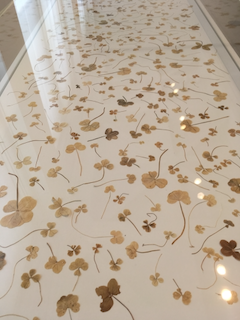Tacita Dean’s four-leaf clover collection vs my four-leaf clover collection
I’ve found and collected hundreds of four-leaf clovers. So has the artist Tacita Dean. What’s the difference between our collections?
by
Four, Five, Six, Seven and Nine Leaf Clover Collection #

There they were, hundreds of four and more leaf clovers arranged in a glass museum case. Some were new, still a bit green. Some very faded, like old parchment. They were not arranged in neat rows or ordered by size like a collection of stamps or dead butterflies, which is what other massive collections of four-leaf clovers make me think of, uncharitably. Yet, they were definitely arranged. Aesthetically, you could say. Yes, very definitely aesthetically.
And not just four-leaf clovers. All the other mutant clovers.
The title and label did not offer much beyond the obvious. Tacita Dean, Four, Five, Six, Seven and Nine Leaf Clover Collection, 1972–present.
1972-present was a hint, though. Tacita Dean had collected all these clovers. Between this, and the Round Stone Collection which was part of the same Royal Academy exhibition in 2018, I felt an intense affinity to her. I liked her chalk drawings and films. But these collections of rocks and clovers were something else.
My four-leaf clover collection #
I first found a four leaf clover when I was somewhere between seven and nine years old. I remember exactly where it happened. My family was visiting some family friends. It was summer. I was in their yard walking back and forth on a gray breezeblock wall marking their garden, bored by whatever the adults were doing inside and not interested in the available other children either. I found a four-leaf clover. Then, almost immediately, I found several more four, five, and six leaf clovers. Perhaps even seven, and more. I was excited and brought them indoors to show the adults. They were so confused by the extraordinary event that they started telling me that four-leaf clovers are common, the normal kind, and it’s only five-leaf clovers that are unusual. I don’t know how they convince themselves of such a stupid thing. Maybe they were drunk. They didn’t convince me, or even outrage me, as far as I remember, because I obviously had the evidence of all the ordinary three-leaf clovers right outside.
Anyway, that’s how my collection started. All my life, I’ve continued to find four and more leaf clovers. I wouldn’t say they are common, but they aren’t as rare as you might think. You just have to actually look for them.
And once you find one, keep looking. They tend to grow in groups. On the other hand, if you look a bit and don't find any, move on and look elsewhere. I suspect it’s because it’s a mutation. Maybe it’s a good lesson in luck, too. If you get lucky in one area, keep going. If you aren’t having any luck, move on and try elsewhere. Anyway, that’s worked for me.
My collection of clovers is still largely pressed between pages of dictionaries, cookbooks, journals, and any fat-enough books. I rediscover them when the clovers flutter out, sometimes even breaking up. Some of my childhood clovers are collected in a glass box in a drawer in my parents’ house. I look at it sometimes when I visit them and wonder if I should preserve them better.
But you know, I just sort of have them.
The difference between a collection and art #
When I saw Tacita Dean’s Four, Five, Six, Seven and Nine Leaf Clover Collection I wasn’t so much amazed that she had collected them–I mean, I was a little but I was more pleased that someone else had a collection like mine–I was amazed that she had made them into art. You can’t say that she took ordinary objects and elevated them, because four-leaf clovers aren’t really ordinary. I don’t think you could say that about the Round Stone Collection, either, because those were extraordinarily round stones. If you like stones, you know a good stone when you see one, and I like stones.
Both collections moved me more than I can quite express, and I suppose that’s one of the points of art, that you can’t necessarily translate its effect into a neat essay or even a rambly blog post. I can say some things about it, though. Tacita Dean’s clover collection felt like a better reflection of my collection, not just my collection but my collecting. It felt like when you fall in love with someone and they fall in love with you, and you see yourself reflected in their loving regard, beautiful and wonderful. And because you love them back, you can’t dismiss that vision of you as wrong because, you see, they are beautiful and wonderful and smart, so they can’t be wrong, and so you become, just a little bit, that person that they see.
Just by existing, Tacita Dean’s clover collection makes my haphazard clover collection better. Somehow, rather than diminish it by comparison, the vision of what’s possible in her art, makes me find my collection more meaningful.
